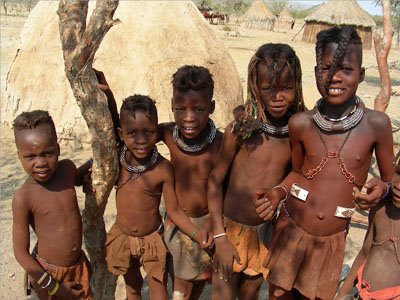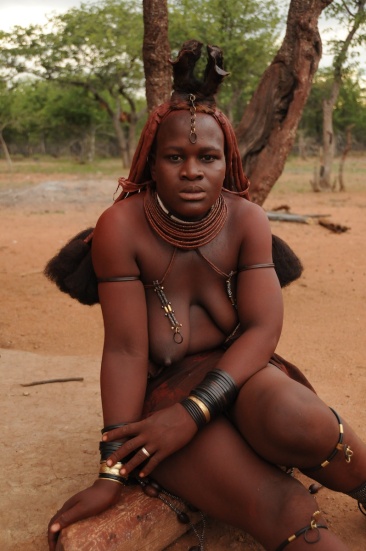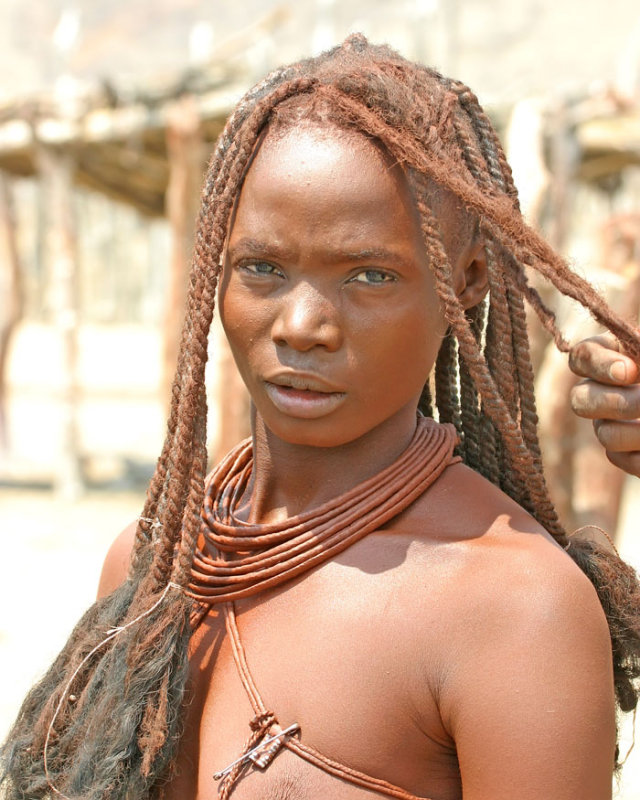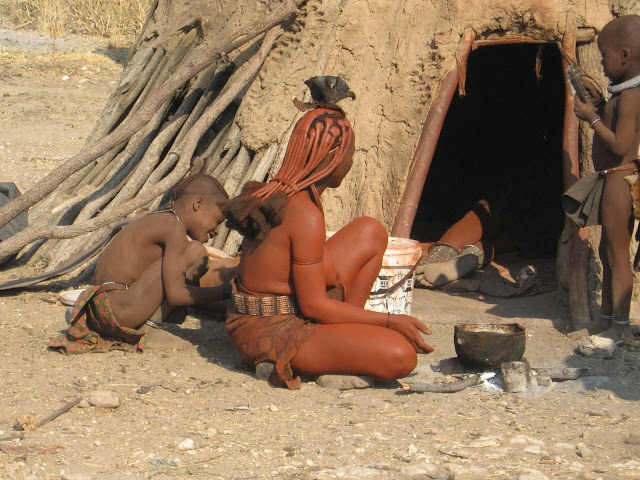HIMBA PEOPLE: AFRICA`S MOST FASHIONABLE TRIBE
The Himba ethnic group have kept their ethnic individuality and culture in the seclusion of Kaokoland. This ancient tribe of semi-nomadic pastoralists live in the Kunene region of northern Namibia. There are between 20,000 and 50,000 Himba people.
Himba people
The friendly and extraordinary Himba people are closely related to the Herero people but they have resisted change and preserved their unique cultural heritage. About 240,000 Herero people live in Namibia, Botswana and Angola. They belong to the Bantu group of African nations.
The Himba and Herero speak the same language. The Himba are a pastoral people. They predominantly breed cattle and goats and lead a nomadic life.Depending on the time of year, they move with their herds to different watering places. Milking of animals as well as other jobs like bringing water to the village and building homes is done by women.
Himba people
The Himbas were impoverished by Nama cattle raiders in the middle of 1800's and then forced to be hunter-gatherers. Because of these events they were called the Tjimba, derived form the word meaning aardvark, the animal that digs for its food. Many Himbas fled to Angola where they were called Ovahimba, meaning 'beggars'. They left with their leader called Vita (''war''). After World War 1 he resettled his people in Kaokoland. Since these events the Himbas were living their nomadic pastoralist lives. But now more and more they have to reconcile traditional ways with European values.
Unofficial Himba chief
One of most interesting rituals of these people is that of the ritual fire, the ''okoruwo''. The fire provides contact between the living and the dead, which is necessary for harmonious living and keeping the ancestors happy. It is kept alive until the death of the headman. When this happens, his hut and the fire is destroyed. His family dance in mourning throughout the night. Before his burial everyone says to him: "Karepo nawa" (''keep well''). Later a fresh mopane tree is lit from the embers of the old fire. Women raise children too. There is a situation that one woman in the community gets a task of raising children. So, she raises children of her own and those of other women in the community. Men on the other side are more involved in political and legal matters.
Himba woman in her traditional dress.
Clothes, hairstyle and jewellery are all of particular significance to the Himba and are part of their tradition and culture. Even newborn babies are adorned with pearl necklaces. When the children are a little older, bangles made of beaten copper and shells are added. The proud Himba women take several hours for beauty care every morning. The entire body is rubbed with a cream, which consists of rancid butterfat and ochre powder. "It has to be said that Himba women do not wear lot of clothes. To somehow protect themselves from the sun they make a paste of butter fat, ochre, and herbs which they later put on their skin. That is why their skin is of reddish colour. The Himba believe that this colour is beautiful. It also has symbolic meaning as it unites the red colour of earth and blood which is the symbol of life. The hairstyle worn by Himba women is also quite unique. The hair is braided ("weaved") and covered with the special ochre mixuture called "otjize". Before reaching the puberty girls have only two hair braids. After the puberty they are allowed to make more of them. Single Himba men have only one braid backwards from the crown of the head. When they get married keep their hair tied in the shape of a turban."
Himba woman and her son
 Himba woman and her baby
Himba woman and her baby
Himba women and their Children in the city
Himba people
The friendly and extraordinary Himba people are closely related to the Herero people but they have resisted change and preserved their unique cultural heritage. About 240,000 Herero people live in Namibia, Botswana and Angola. They belong to the Bantu group of African nations.
The Himba and Herero speak the same language. The Himba are a pastoral people. They predominantly breed cattle and goats and lead a nomadic life.Depending on the time of year, they move with their herds to different watering places. Milking of animals as well as other jobs like bringing water to the village and building homes is done by women.
Himba people
The Himbas were impoverished by Nama cattle raiders in the middle of 1800's and then forced to be hunter-gatherers. Because of these events they were called the Tjimba, derived form the word meaning aardvark, the animal that digs for its food. Many Himbas fled to Angola where they were called Ovahimba, meaning 'beggars'. They left with their leader called Vita (''war''). After World War 1 he resettled his people in Kaokoland. Since these events the Himbas were living their nomadic pastoralist lives. But now more and more they have to reconcile traditional ways with European values.
Unofficial Himba chief
One of most interesting rituals of these people is that of the ritual fire, the ''okoruwo''. The fire provides contact between the living and the dead, which is necessary for harmonious living and keeping the ancestors happy. It is kept alive until the death of the headman. When this happens, his hut and the fire is destroyed. His family dance in mourning throughout the night. Before his burial everyone says to him: "Karepo nawa" (''keep well''). Later a fresh mopane tree is lit from the embers of the old fire. Women raise children too. There is a situation that one woman in the community gets a task of raising children. So, she raises children of her own and those of other women in the community. Men on the other side are more involved in political and legal matters.
Himba woman in her traditional dress.
Clothes, hairstyle and jewellery are all of particular significance to the Himba and are part of their tradition and culture. Even newborn babies are adorned with pearl necklaces. When the children are a little older, bangles made of beaten copper and shells are added. The proud Himba women take several hours for beauty care every morning. The entire body is rubbed with a cream, which consists of rancid butterfat and ochre powder. "It has to be said that Himba women do not wear lot of clothes. To somehow protect themselves from the sun they make a paste of butter fat, ochre, and herbs which they later put on their skin. That is why their skin is of reddish colour. The Himba believe that this colour is beautiful. It also has symbolic meaning as it unites the red colour of earth and blood which is the symbol of life. The hairstyle worn by Himba women is also quite unique. The hair is braided ("weaved") and covered with the special ochre mixuture called "otjize". Before reaching the puberty girls have only two hair braids. After the puberty they are allowed to make more of them. Single Himba men have only one braid backwards from the crown of the head. When they get married keep their hair tied in the shape of a turban."
Himba woman and her son
Himba women have a rather interesting way to make them smell nice. How do they do it? They slowly burn certain aromatic plants and resins and use the smoke created to perfume and clean themselves. The Himba wear lot of leather jewelry. They often combine it with shells. Western style of fashion appears too but only on men. Both men and women walk topless. They wear skirts or loincloths made of animal skin. Adult women wear beaded anklets. They are used to protect them from snake bites.
On the Move Again (Carrying only the essentials, a Himba woman totes her baby, sleeping skin, and gourds for fermented cow's milk. As the Himba trek from permanent homesteads to temporary grazing lands, the walking women churn milk into butter in the gourds they carry.)
Himba woman bathing her child
Both boys and girls are circumcised before reaching puberty. During the circumcision boys should be silent and girls are encouraged to scream. The Himba believe that this act makes them ready for wedding. As soon as the girl is born, her future husband is decided. They get married when the girl is between 14 and 17 years old.
Bridal Party
Every member of certain tribal community belongs to two clans – a "patriclan" (through the father) and "matriclan" (through the mother). It means that the Himba people have a bilateral system of descent. On top of each clan there is the eldest man of the clan. Sons live with their father's clan. When girls get married they move to the clan of their husband.
Inheritance of goods is done with the domination of the matriclan. Let's imagine that a man dies. His son will not get the cattle that belonged to the deceased. Instead the uncle (mother's brother) will become the new owner of the cattle.
Himba Girl standing by her kraal
In everyday life the Himba people worship the god Mukuru and their ancestors. The fire-keeper is an important person in every family. He keeps the family ancestral fire burning. Every 7 to 10 days he uses the fire to communicate with the Mukuru and family ancestors. The direct communication with the Mukuru is not always possible. The Himba believe that the Mukuru is quite a busy guy so the family ancestors operate as his representatives.
(An old woman suffering from chest pain throws down her head as a healer with a calabash tries to draw a spirit from her body. For everyday "illnesses of the flesh," such as snake bites or wounds, the Himba use medicinal herbs or go to Western clinics and hospitals. For chronic or life-threatening illnesses they turn to healers, who exorcise spirits. More and more, women turn to other women in group trancing or healing sessions that anthropologist Margaret Jacobsohn thinks help them cope with rapid changes in their society—expanding tourism, the increased importance of the cash economy, children going to school, the growing influence of the national government—that are redefining their roles and undermining their authority.)
HIMBA DANCES - Part 1
4,305,243 views, Published 1 yr ago
By patrickcerpentier1
Himba Namibia
Himba Namibia
The Himba live in relatively isolated communities. They manage to survive and keep their traditions despite harsh desert environment they live in. The nature has not always been their only problem. Let's mention just one example. In 1904 they suffered from genocide organized by German colonial authorities led by Lothar von Trotha (1848-1920).
Himba sub-chief and his kids
In 1980s the drought killed almost all of their cattle. They became refugees in the town of Opuwo. Since the 1990s their position has improved. Many of them live now in the nature protected areas. They can again live freely and have some use from the tourists. But new trouble appeared on the horizon. Namibian government plans to build the hydroelectric Epupa dam on the Cunene river. Many believe that building of the dam could create floods and seriously endanger the survival of the Himba.
Himba women and their Children in the city














































.jpg)










































You are so beautiful!! I am from Kenya, Taita Hills and we lost all our cultural dressing. Guard yours.
ReplyDeleteVery Impressive, they look so relaxed and have none of our stressful lives. Envy them a lot.
ReplyDeleteUncle J B, Tarkwa, Ghana: This is real tradition & culture, but some does not speak well of Africans but the whites likes them too much, especially the natural settings. May God the creator bless u.
ReplyDeletewwoooh
ReplyDeletei love it!
Thank you very much! As an African fashion designer, I always wondered what the real African dress is.The motto of my label is "Femininity Empowered" and these women are truly the embodiment of that motto: they look strong, proud and confident. I am so inspired by this and would surely like to use some elements of these styles to feature in my next clothing line.
ReplyDeleteDidn't have time to read it yet, but what a spectacular collection of pictures!!! All peoples are beautiful, but the Himba really stand out. This is how humans are meant to be, I wish we could all still live like this. :)
ReplyDeleteThis is a grate work and culture I wish i can paint some soon
ReplyDelete